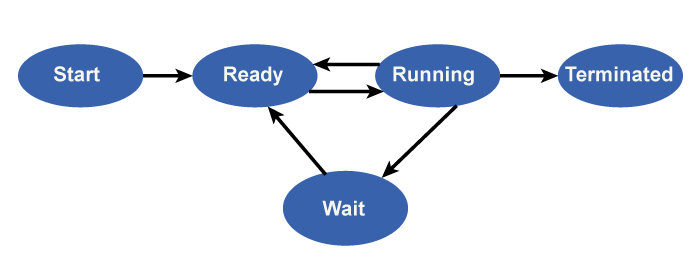Process Management in Operating System (OS)
Process Management in Operating System (OS)
Introduction
Process management is a function of an operating system (OS) that controls the execution and synchronization of several processes within a computer system. It entails managing process lifecycles, allocating system resources, and guaranteeing effective CPU utilization. This article describes process management in an operating system, highlighting its essential components and functions. Before starting the topic, lets first understand some basic terms used for Process Management.
Crucial Aspects of Process Management in OS
What is Process?
A process can be defined as an instance of a program in execution. Each process has its memory space, program counter, registers, and other relevant information. The OS is responsible for creating, scheduling, and terminating processes. Process creation involves allocating necessary resources, setting up data structures, and initializing the process's context.
Process Scheduling
Process scheduling is a vital aspect of process management. It determines the order in which processes are executed on the CPU. Various scheduling algorithms, such as round-robin, shortest job next, and priority scheduling, allocate CPU time fairly and efficiently among processes. The scheduler selects the next process that will execute next based on predefined characteristics such as priority, execution time, and needs for resources.
Inter-Process Communication (IPC)
IPC mechanisms include shared memory, message passing, pipes, and sockets. These mechanisms facilitate collaboration among processes, allowing them to coordinate their activities effectively.
Process Synchronization
Process synchronization is another critical aspect of process management, and it ensures that multiple processes cooperate without interfering or conflicting with each other. Synchronization mechanisms, such as locks, semaphores, and monitors, enforce mutual exclusion, prevent race conditions, and establish order in accessing shared resources.
Process Suspension and Resumption
Process suspension and resumption are essential functions provided by the OS. A process may be suspended or blocked when waiting for a particular event or resource. Once the event occurs or the resource becomes available, the OS resumes the process, allowing it to continue execution. This mechanism enhances resource utilization and responsiveness.
Process Termination
Process termination is the final stage in the lifecycle of a process. When a process completes its execution or is explicitly terminated by the OS, it undergoes termination. The OS reclaims the resources allocated to the process, updates relevant data structures, and notifies other processes about the termination.
Process Management Cycle
The process management cycle in an operating system consists of several stages, including the "Start", "Ready," "Running", "Waiting", and "Terminated" states. Let's delve into each of these states:

- Start State:
The "Start" state describes a process's starting state before it begins execution. A process enters the "Start" state when created or called. The operating system initiates the process, allocates resources, and prepares it for execution.
- Ready State:
The "Ready" state is reached when a process is established or gets ready to run after waiting for a resource or an event.
The process is loaded into the main memory in the "Ready" state, and its PCB is updated to reflect the state transition. The process is now eligible for execution and awaits its turn to be allocated the CPU by the scheduler.
- Running State:
When a process from the "Ready" state is allocated to the CPU, it enters the "Running" state. In the "Running" stage, the process executes its instructions on the CPU.
The operating system supplies the required resources, such as memory and I/O devices, to complete its job.
The process continues to execute until it either completes its execution, willingly concedes the CPU or is halted by an external event.
- Waiting State:
A process may meet instances during execution when it must wait on a certain event or resource before proceeding.
The procedure enters the "Waiting" stage in such instances. The operating system changes the process's state to "Waiting" and frees up the CPU for other processes to utilize.
The process is blocked and does not consume CPU time until the desired event or resource becomes available.
The process may wait for various reasons, such as I/O operations, synchronization with other processes, or the completion of a particular event.
- Terminated State:
The "Terminated" state represents the final stage of a process when it has completed its execution or is explicitly terminated by the operating system.
When a process finishes executing its instructions or reaches an exit point in its program, it enters the "Terminated" state. The operating system executes cleanup activities, reallocates the process's resources, and releases the PCB and other related data structures.
When a process reaches the "Terminated" stage, it leaves the process management cycle. The "Start" state depicts a process's initial setup before it is ready for execution. The "Terminated" state denotes the conclusion of a process's execution or its termination by the operating system.
The process management cycle involves transitioning processes between these states based on their execution progress, resource availability, and external events. This cycle continues as long as there are active processes in the system.
A process's usual state sequence is as follows:
| Start -> Ready -> Running -> Waiting -> Ready -> Running -> Terminated |
However, the actual sequence and transitions may vary depending on the scheduling algorithm, the occurrence of events, and the resource availability within the operating system.